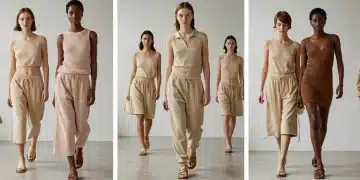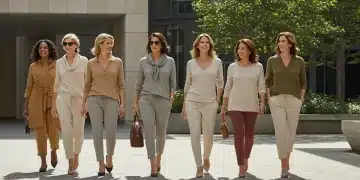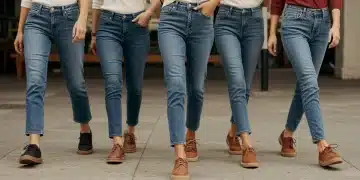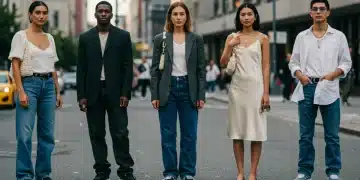2025 Fashion Trends Report: Key Styles & Colors for Women’s Wear

Understanding the 2025 Fashion Trends Report: Key Styles and Colors Dominating Women’s Wear Next Season is crucial for anyone in the fashion industry or a style enthusiast looking to stay ahead. The recently released report offers a comprehensive look into what will define women’s apparel.
Emerging Silhouettes: Redefining Form and Function
The 2025 Fashion Trends Report highlights a significant shift towards silhouettes that blend comfort with sophisticated structure. Designers are moving beyond transient fads to embrace forms that offer both aesthetic appeal and practical wearability, reflecting a post-pandemic desire for versatile clothing. This evolution emphasizes fluidity and adaptability, allowing garments to transition seamlessly between various settings and occasions.
Expect to see a strong presence of oversized tailoring, juxtaposed with more fitted, body-conscious elements. This creates a fascinating play on proportions, offering a fresh take on classic designs. The focus is on creating a sense of effortless chic, where garments drape elegantly rather than restrict, providing freedom of movement while maintaining a polished appearance.
The Rise of Deconstructed Classics
Deconstructed classics are set to dominate, offering a modern twist on timeless pieces. Think blazers with unexpected cut-outs or trench coats with asymmetrical hems. This approach allows for individual expression while retaining a sense of familiarity.
- Asymmetrical lines in skirts and dresses.
- Layered transparencies for subtle depth.
- Exaggerated sleeves and shoulder pads making a strong comeback.
Fluidity and Movement
Movement is a key theme, with fabrics and cuts designed to flow with the body. This includes wide-leg trousers, maxi skirts, and draped tops that create a dynamic silhouette. The emphasis is on comfort without compromising on style, catering to a lifestyle that values both ease and elegance.
Dominant Color Palettes: Nature’s Influence and Digital Hues
The 2025 Fashion Trends Report unveils a fascinating duality in color palettes, drawing inspiration from both the natural world and the accelerating digital landscape. This convergence creates a rich and diverse spectrum, moving beyond seasonal limitations to offer year-round relevance. Consumers are increasingly seeking colors that evoke a sense of calm and grounding, alongside vibrant tones that reflect optimism and technological advancement.
Muted earth tones and serene pastels will form the cornerstone of many collections, offering a sophisticated and timeless appeal. These shades, reminiscent of landscapes and natural elements, provide a sense of stability and connection. Simultaneously, electric brights and luminous metallics will inject energy and modernity, reflecting our digitally-driven lives and a desire for bold self-expression.
Earthy Neutrals and Serene Pastels
The core palette for 2025 heavily features shades like sage green, terracotta, sandy beige, and muted blues. These colors promote a sense of tranquility and sustainability, aligning with broader societal values.
- Soft lavenders and mint greens for a delicate touch.
- Warm browns and deep olives for grounding.
- Creamy off-whites offering versatile elegance.
Vibrant Accents and Metallics
Contrasting the subdued tones, expect pops of electric blue, fuchsia, and radiant orange. These bold choices are often seen in accessories or as statement pieces, adding a dynamic edge. Metallics, particularly silver and iridescent finishes, are also prominent, echoing futuristic themes.
Key Fabric Innovations: Sustainability and Texture
Innovation in textiles is a cornerstone of the 2025 Fashion Trends Report, with a strong emphasis on sustainability and tactile experiences. As consumer awareness grows regarding environmental impact, brands are prioritizing eco-friendly materials and ethical production methods. This drive towards responsible fashion is not just a trend but a fundamental shift in industry practices, influencing everything from raw material sourcing to manufacturing processes.
Alongside sustainability, texture plays a crucial role. Fabrics are being developed not only for their environmental credentials but also for their unique feel and visual interest. Expect to see a blend of natural fibers with advanced synthetics, creating a new generation of materials that are both luxurious and conscientious. The focus is on materials that offer comfort, durability, and a reduced footprint.
Eco-Conscious Materials
Recycled and upcycled fabrics, organic cotton, hemp, and innovative bio-based materials like mushroom leather are gaining prominence. The industry is moving towards circularity, minimizing waste and maximizing resource efficiency.
- Recycled polyester and nylon from ocean plastics.
- Tencel and Modal for their soft feel and sustainable production.
- Innovative vegan leather alternatives.
Tactile and Sensory Textures
Texture adds depth and interest to garments. Expect a mix of soft, brushed finishes, intricate knits, and unexpected embellishments. Fabrics with subtle irregularities or natural slubs will also be popular, celebrating authenticity and craftsmanship.
The Return of Craftsmanship: Hand-Touched Details
The 2025 Fashion Trends Report underscores a significant resurgence of craftsmanship, moving away from mass-produced uniformity towards pieces that celebrate human touch and artisanal skill. This trend reflects a growing consumer appreciation for authenticity, individuality, and the narrative behind a garment. In an increasingly digital world, there’s a longing for tangible, unique items that carry a sense of history and human effort.
This focus on craftsmanship manifests in various forms, from intricate embroidery and hand-painted details to bespoke tailoring and unique embellishments. It’s about celebrating the imperfections and uniqueness that come with handmade items, offering a refreshing contrast to the often sterile nature of fast fashion. This shift not only supports traditional artisans but also encourages a more mindful approach to consumption.
Artisanal Embellishments
Hand-embroidered motifs, intricate beading, and delicate lace work will adorn garments, making each piece unique. These details add a luxurious and personalized touch, elevating everyday wear.
Bespoke and Customization
The desire for unique items fuels a demand for bespoke services and customizable options. Consumers are looking to invest in pieces that truly reflect their personality and fit perfectly, moving away from off-the-rack conformity.
Sustainability as a Core Design Principle
Sustainability is no longer a niche concern but a fundamental design principle woven throughout the 2025 Fashion Trends Report. It dictates material choices, production processes, and even the lifespan of garments. This holistic approach signals a maturing industry commitment to environmental responsibility, driven by both consumer demand and regulatory pressures. Brands are increasingly transparent about their supply chains and environmental impact, fostering greater trust and accountability.
Designers are integrating sustainable practices from the initial concept phase, focusing on longevity, versatility, and recyclability. This includes designing for minimal waste, utilizing upcycled components, and creating multi-functional garments that reduce the need for excessive purchases. The emphasis is on creating beautiful, desirable fashion that respects planetary boundaries, challenging the traditional linear model of production and consumption.
Circular Fashion Initiatives
Brands are investing in take-back programs, repair services, and initiatives that promote garment recycling and upcycling. The goal is to keep materials in use for as long as possible, reducing landfill waste.
- Partnerships with textile recycling companies.
- Designing garments for easy disassembly and material recovery.
- Promoting second-hand and vintage fashion.
Transparency and Ethical Sourcing
Consumers demand to know where their clothes come from and how they are made. Brands are responding by providing detailed information about their supply chains, ensuring fair labor practices and environmentally sound sourcing.
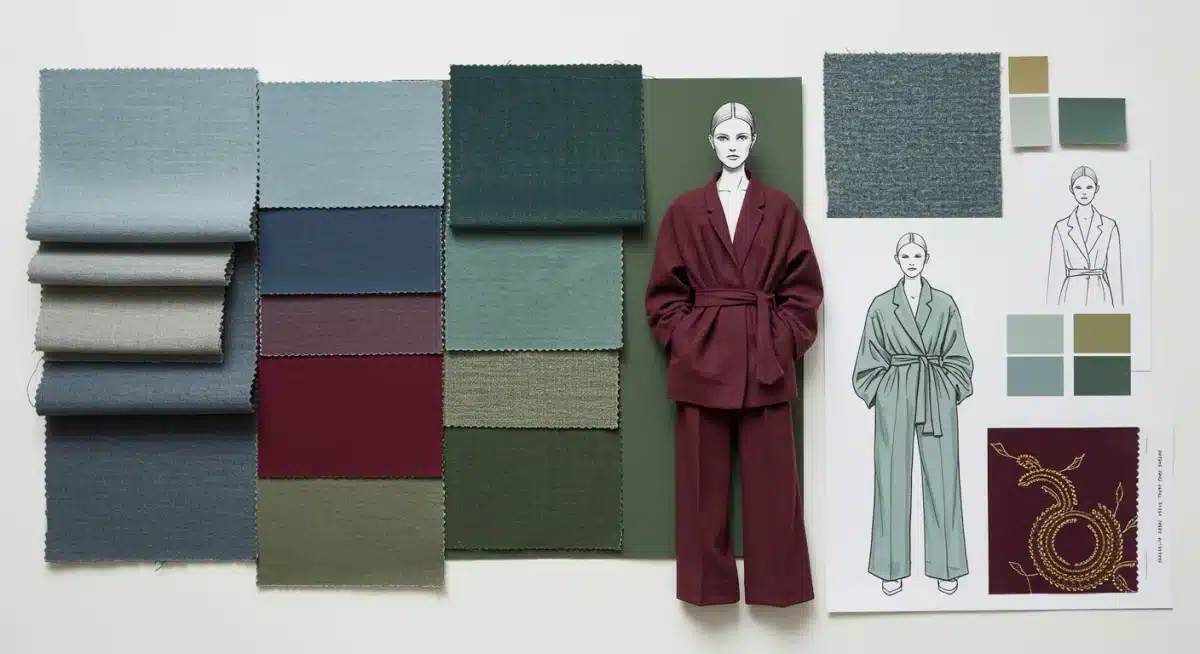
Technological Integration: Smart Fabrics and Digital Fashion
The 2025 Fashion Trends Report reveals a significant acceleration in the integration of technology into women’s wear, moving beyond mere aesthetics to enhance functionality and user experience. This fusion of fashion and tech opens up new frontiers for design, material science, and consumer interaction. Smart fabrics and digital fashion are not just futuristic concepts but are becoming tangible realities, reshaping how we perceive and interact with clothing.
Expect to see garments embedded with sensors for health monitoring, temperature regulation, and even mood indication. Digital fashion, including NFTs and virtual try-ons, will continue to expand, blurring the lines between physical and virtual wardrobes. This technological embrace aims to make clothing more intuitive, interactive, and personalized, catering to a tech-savvy consumer base that values innovation and connectivity.
Wearable Technology
Beyond fitness trackers, clothing will incorporate subtle tech for practical benefits. Think self-heating jackets, garments that monitor UV exposure, or activewear that tracks performance with greater precision.
- Fabrics with integrated LED elements.
- Garments with adaptive climate control.
- Smart accessories with enhanced connectivity.
The Metaverse and Digital Wardrobes
Digital fashion will continue its ascent, offering virtual clothing for online avatars, gaming, and social media. NFTs representing unique digital garments provide new avenues for ownership and expression in the metaverse.
Inclusive Design: Fashion for Every Body
A pivotal aspect highlighted in the 2025 Fashion Trends Report is the unwavering commitment to inclusive design, ensuring fashion is accessible and appealing to every body type, age, and identity. This movement transcends mere tokenism, embedding inclusivity as a core philosophy from conceptualization to retail. The industry recognizes the diverse tapestry of consumers and the imperative to cater to a broader spectrum of needs and preferences, moving away from antiquated, narrow ideals of beauty.
This commitment manifests in expanded sizing ranges, gender-neutral collections, and adaptive clothing features. Designers are actively engaging with diverse communities to understand specific requirements, leading to more thoughtful and functional designs. The goal is to create a fashion landscape where everyone feels seen, represented, and empowered to express themselves authentically through their clothing, fostering a more equitable and welcoming industry.
Expanded Sizing and Fit
Brands are increasingly offering a wider range of sizes, ensuring that fashionable and well-fitting options are available for all body shapes. This includes detailed fit guides and customizable elements.
Adaptive Clothing Solutions
Designs are incorporating features for individuals with disabilities, such as magnetic closures, adjustable hemlines, and easy-access openings, making dressing more manageable and stylish.
Gender-Neutral Collections
The blurring of traditional gender lines in fashion continues, with more brands offering collections that are designed to be worn by anyone, regardless of gender identity. This embraces fluidity and personal expression.
| Key Trend | Brief Description |
|---|---|
| Emerging Silhouettes | Focus on fluid, oversized tailoring with deconstructed classics, blending comfort and sophisticated structure. |
| Dominant Color Palettes | A mix of serene earth tones, pastels, and vibrant digital hues, reflecting nature and technology. |
| Sustainability & Texture | Prioritizing eco-conscious materials like recycled fabrics and bio-based alternatives, alongside rich, tactile textures. |
| Technological Integration | Incorporation of smart fabrics and digital fashion elements, enhancing functionality and virtual presence. |
Frequently Asked Questions About 2025 Fashion Trends
The 2025 fashion trends report indicates a dual palette: serene earth tones and pastels for a grounded feel, alongside vibrant electric hues and metallics for a modern, digital edge. Expect a sophisticated blend that offers versatility and bold statements.
Sustainability is a core design principle, driving the use of recycled, upcycled, and bio-based materials. Circular fashion initiatives, ethical sourcing, and transparency are paramount, influencing everything from fabric choices to production methods and garment longevity.
Fluid and oversized tailoring will be prominent, often deconstructed for a modern twist. Expect comfort-driven shapes like wide-leg trousers and draped tops, emphasizing movement and a sophisticated, effortless aesthetic that blends structure with ease.
Yes, technology is increasingly integrated. Smart fabrics for health monitoring or climate control, alongside digital fashion in the metaverse (NFTs, virtual try-ons), are set to expand, blurring lines between physical and virtual wardrobes and enhancing functionality.
Inclusive design is a fundamental aspect, with an emphasis on expanded sizing ranges, gender-neutral collections, and adaptive clothing features. The aim is to create fashion that is accessible and empowering for every body type, age, and identity, promoting broader representation.
Looking Ahead: The Evolving Landscape of Women’s Wear
The insights highlighted in the 2025 Fashion Trends Report reveal a fashion industry in active transformation—one that is moving beyond aesthetics and embracing a mindset of purpose-driven design. Women’s wear is no longer defined solely by seasonal silhouettes but by a growing demand for sustainability, digital innovation, and identity-led styling. This shift is evident in how major fashion authorities, including global platforms that track ongoing fashion trends and designer direction, such as Vogue (https://www.vogue.com/fashion/trends), are increasingly spotlighting ethical craftsmanship and long-term wardrobe value over disposable trends.
Looking ahead, the rise of circular fashion systems, rental capsules, and AI-driven personalization will reshape how women approach clothing consumption. Brands are expected to invest more heavily in eco-engineered fabrics, transparent sourcing, and modular design concepts that encourage longevity rather than fast turnover. Simultaneously, the resurgence of artisanal detailing and tailored silhouettes signals a renewed appreciation for craftsmanship, even within tech-enhanced fashion ecosystems.
Consumers can expect a more interactive and customized shopping experience, blending digital previews, try-on technology, and curated styling intelligence. In this new era, fashion evolves into a more conscious and expressive language—one where comfort, ethics, and innovation coexist. Ultimately, the future of women’s wear will be defined by this balance: honoring heritage while boldly embracing the possibilities of modern design.

